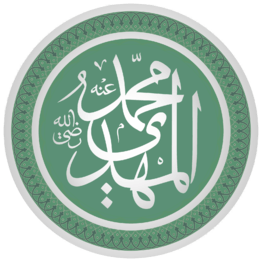The Twelve Imams
| |||
|---|---|---|---|
| The Fourteen Infallibles | |||
|
|||
| Principles | |||
| Other beliefs | |||
| Practices | |||
| Holy cities | |||
| Groups | |||
|
|
|||
| Scholarship | |||
| Hadith collections | |||
| Related topics | |||
| Related portals | |||
|
|||
The Twelve Imams are the spiritual and political successors to the Islamic prophet Muhammad in the Twelver or Athnā‘ashariyyah branch of Shia Islam and in Alevi Islam.[1] According to the theology of Twelvers, the Twelve Imams are exemplary human individuals who not only rule over the community with justice, but also are able to keep and interpret sharia and the esoteric meaning of the Quran. Muhammad and Imams' words and deeds are a guide and model for the community to follow; as a result, they must be free from error and sin, known as Ismah or infallibility and must be chosen by divine decree, or nass, through the Prophet.[2][3]
The belief of Imamah
Athnā‘ashariyyah Shi‘ah |
|---|
It is believed in Twelver Shia Islam that ‘aql, divine wisdom, is the source of the souls of the Prophets and Imams and gives them esoteric knowledge called Hikmah and that their sufferings are a means of divine grace to their devotees.[4][5] Although the Imam is not the recipient of a divine revelation, he has a close relationship with God, through which God guides him, and the Imam in turn guides the people. The Imams are also guided by secret texts in their possession, such as al-Jafr and al-Jamia. Imamate, or belief in the divine guide is a fundamental belief in the Twelver Shia doctrine and is based on the concept that God would not leave humanity without access to divine guidance.[6]
According to Twelvers, there is always an Imam of the era, who is the divinely appointed authority on all matters of faith and law in the Muslim community. Ali was the first of the Twelve Imams, and, in the Twelvers and sufis' view, the rightful successor to Muhammad, followed by male descendants of Muhammad through his daughter Fatimah. Each Imam was the son of the previous Imam, with the exception of Husayn ibn Ali, who was the brother of Hasan ibn Ali. The twelfth and final Imam is Muhammad al-Mahdi, who is believed by the Twelvers to be currently alive, and hidden in the Major Occultation until he returns to bring justice to the world.[6] It is believed by Twelver Shia and Alevi Muslims that the Twelve Imams have been foretold in the Hadith of the Twelve Successors. All of the Imams met unnatural deaths, with the exception of the last Imam, who according to Twelver and Alevi belief, is living in occultation.
The Twelve Imams also have a leading role within some Sufi orders and are seen as the spiritual heads of Islam, because most of the Silsila (spiritual chain) of Sufi orders lead back to one of the Twelve Imams.
List of Imams
| Number | Modern (Calligraphic) Depiction | Name (Full/Kunya) | Title (Arabic/Turkish)[7] | Date of Birth Death (CE/AH)[8] | Importance | Place of birth | Reason & place of death and place of burial[9] |
|---|---|---|---|---|---|---|---|
| 1 | الإمام علي بن أبي طالب عليه السلام Abu al-Hasan أبو الحسن |
Amir al-Mu'minin (Commander of the Faithful)[10]
|
600–661[10] 23 (before Hijra)–40[12] |
Cousin and son in law of Mohammed. Considered by Shia Islam as the rightful Successor of Muhammad. The Sunnis acknowledge him as the fourth Caliph. He holds a high position in almost all Sufi Muslim orders (Turuq); the members of these orders trace their lineage to Muhammad through him.[10] | Mecca[10] | Assassinated by Abd-al-Rahman ibn Muljam, a Kharijite, in Kufa, who slashed him with a poisoned sword while he was praying.[10][13] Buried at the Imam Ali Mosque in Najaf, Iraq. | |
| 2 |  |
Hasan ibn Ali الإمام الحسن بن علي عليه السلام Abu Muhammad أبو محمد |
al-Mūjtabā
İkinci Ali[11] |
625–670[14]
3–50[15] |
He was the eldest surviving grandson of Muhammad through Muhammad's daughter, Fatimah az-Zahra. Hasan succeeded his father as the caliph in Kufa, and on the basis of peace treaty with Muawiya I, he relinquished control of Iraq following a reign of seven months.[14] | Medina[14] | Poisoned by his wife in Medina, Saudi Arabia on the orders of the Caliph Muawiya, according to Twelver Shiite belief.[16] Buried in Jannat al-Baqi, Medina, Saudi Arabia. |
| 3 |  |
Husayn ibn Ali الإمام الحسین بن علي عليه السلام Abu Abdillah أبو عبدالله |
Sayyid ash-Shuhada
Üçüncü Ali[11] |
626–680[17]
4–61[18] |
He was a grandson of Muhammad and brother of Hasan ibn Ali. Husayn opposed the validity of Caliph Yazid I. As a result, he and his family were later killed in the Battle of Karbala by Yazid's forces. After this incident, the commemoration of Husayn ibn Ali has become a central ritual in Shia identity.[17] | Medina[17] | Killed and beheaded at the Battle of Karbala. Buried at the Imam Husayn Shrine in Karbala, Iraq.[17] |
| 4 |  |
Ali ibn Husayn الإمام علي بن الحسین السجاد عليه السلام Abu Muhammad أبو محمد |
al-Sajjad, Zayn al-'Abidin
Dördüncü Ali[11] |
658/9[19] – 712[20]
|
Author of prayers in Sahifa al-Sajjadiyya, which is known as "The Psalm of the Household of the Prophet."[20] | Medina[19] | According to most Shia scholars, he was poisoned on the order of Caliph al-Walid I in Medina, Saudi Arabia.[20] Buried in Jannat al-Baqi, Medina, Saudi Arabia. |
| 5 |  |
Muhammad ibn Ali الإمام محمد بن علي الباقر عليه السلام Abu Ja'far أبو جعفر |
Baqir al-Ulum
Beşinci Ali[11] |
677–732[21]
57–114[21] |
Sunni and Shia sources both describe him as one of the early and most eminent legal scholars, teaching many students during his tenure.[21][22] | Medina[21] | According to some Shia scholars, he was poisoned by Ibrahim ibn Walid ibn 'Abdallah in Medina, Saudi Arabia on the order of Caliph Hisham ibn Abd al-Malik.[20] Buried in Jannat al-Baqi, Medina, Saudi Arabia. |
| 6 |  |
Ja'far ibn Muhammad الإمام جعفر بن محمد الصادق عليه السلام Abu Abdillah[23] أبو عبدالله |
as-Sadiq[24]
Altıncı Ali[11] |
702–765[24]
83–148[24] |
Established the Ja'fari jurisprudence and developed the theology of Twelvers. He instructed many scholars in different fields, including Abu Hanifah and Malik ibn Anas in fiqh, Wasil ibn Ata and Hisham ibn Hakam in Islamic theology, and Geber in science and alchemy.[24] | Medina[24] | According to Shia sources, he was poisoned in Medina, Saudi Arabia on the order of Caliph Al-Mansur.[24] Buried in Jannat al-Baqi, Medina, Saudi Arabia. |
| 7 |  |
Musa ibn Ja'far الإمام موسی بن جعفر الكاظم عليه السلام Abu al-Hasan I أبو الحسن الاول[25] |
al-Kazim[26]
Yedinci Ali[11] |
744–799[26]
128–183[26] |
Leader of the Shia community during the schism of Ismaili and other branches after the death of the former Imam, Jafar al-Sadiq.[27] He established the network of agents who collected khums in the Shia community of the Middle East and the Greater Khorasan. He holds a high position in Mahdavia; the members of these orders trace their lineage to Muhammad through him.[28] | Medina[26] | Imprisoned and poisoned in Baghdad, Iraq on the order of Caliph Harun al-Rashid, according to Shiite belief. Buried in the Al-Kadhimiya Mosque in Baghdad, Iraq.[26] |
| 8 |
|
Ali ibn Musa الإمام علي بن موسی الرضا عليع السلام Abu al-Hasan II أبو الحسن الثانی[25] |
ar-Rida, Reza[29]
Sekizinci Ali[11] |
765–817[29]
148–203[29] |
Made crown-prince by Caliph Al-Ma'mun, and famous for his discussions with both Muslim and non-Muslim religious scholars.[29] | Medina[29] | According to Shia sources, he was poisoned in Mashad, Iran on the order of Caliph Al-Ma'mun. Buried in the Imam Reza shrine in Mashad, Iran.[29] |
| 9 |  |
Muhammad ibn Ali الإمام محمد بن علي الجواد عليه السلام Abu Ja'far أبو جعفر |
al-Taqi, al-Jawad[30]
Dokuzuncu Ali[11] |
810–835[30]
195–220[30] |
Famous for his generosity and piety in the face of persecution by the Abbasid caliphate. | Medina[30] | Poisoned by his wife, Al-Ma'mun's daughter, in Baghdad, Iraq on the order of Caliph Al-Mu'tasim, according to Shiite sources. Buried in the Al-Kadhimiya Mosque in Baghdad, Iraq.[30] |
| 10 |  |
Ali ibn Muhammad الإمام علي بن محمد الهادي عليه السلام Abu al-Hasan III أبو الحسن الثالث[31] |
al-Hadi, al-Naqi[31]
Onuncu Ali[11] |
827–868[31]
212–254[31] |
Strengthened the network of deputies in the Shia community. He sent them instructions, and received in turn financial contributions of the faithful from the khums and religious vows.[31] | Surayya, a village near Medina[31] | According to Shia sources, he was poisoned in Samarra, Iraq on the order of Caliph Al-Mu'tazz.[32] Buried in the Al Askari Mosque in Samarra, Iraq. |
| 11 |  |
Hasan ibn Ali الإمام حسن بن علي العسكري عليه السلام Abu Muhammad أبو محمد |
al-Askari[33]
Onbirinci Ali[11] |
846–874[33]
232–260[33] |
For most of his life, the Abbasid Caliph, Al-Mu'tamid, placed restrictions on him after the death of his father. Repression of the Shiite population was particularly high at the time due to their large size and growing power.[34] | Medina[33] | According to Shia, he was poisoned on the order of Caliph Al-Mu'tamid in Samarra, Iraq. Buried in Al Askari Mosque in Samarra, Iraq.[35] |
| 12 |  |
Muhammad ibn al-Hasan الإمام محمد بن الحسن المهدي عجل الله تعالى فرجه الشريف Abu al-Qasim أبو القاسم |
Mahdi,[36] Hidden Imam,[37] al-Hujjah[38]
Onikinci Ali[11] |
868–unknown[39]
255–unknown[39] |
According to Twelver Shiite doctrine, Sufis and some of Sunni Muslims, he is an actual historical personality and is the current Imam and the promised Mahdi, a messianic figure who will return with Christ. He will reestablish the rightful governance of Islam and replete the earth with justice and peace.[40] | Samarra, Iraq[39] | According to Twelver Shiite doctrine, Sufis and some of Sunni Muslims, he has been living in the Occultation since 872, and will continue as long as God wills.[39] |
See also
- Ahl al-Bayt
- Alevi
- Bektashi
- Hadith of the Twelve Successors
- The Fourteen Infallibles
- Imamah (Shia Twelver doctrine)
- Islamic leadership
- Shia Islam
- Succession to Muhammad
- Sufism
- Twelvers
- Wali
Footnotes
- ↑ Olsson, Ozdalga & Raudvere 2005, p. 65
- ↑ Tabataba'i 1977, p. 10
- ↑ Momen 1985, p. 174
- ↑ Tabataba'i 1977, p. 15
- ↑ Corbin 2014, pp. 45–51
- 1 2 Gleave, Robert. "Imamate". Encyclopaedia of Islam and the Muslim world; vol.1. MacMillan. ISBN 0-02-865604-0.
- ↑ The Imam's Arabic titles are used by the majority of Twelver Shia who use Arabic as a liturgical language, including the Usooli, Akhbari, Shaykhi, and to a lesser extent Alawi. Turkish titles are generally used by Alevi, a fringe Twelver group, who make up around 10% of the world Shia population. The titles for each Imam literally translate as "First Ali", "Second Ali", and so forth. Encyclopedia of the Modern Middle East and North Africa. Gale Group. 2004. ISBN 978-0-02-865769-1.
- ↑ The abbreviation CE refers to the Common Era solar calendar, while AH refers to the Islamic Hijri lunar calendar.
- ↑ Except Twelfth Imam
- 1 2 3 4 5 Nasr, Seyyed Hossein. "Ali". Encyclopædia Britannica Online. Retrieved 2007-10-12.
- 1 2 3 4 5 6 7 8 9 10 11 12 Encyclopedia of the Modern Middle East and North Africa. Gale Group. 2004. ISBN 978-0-02-865769-1.
- ↑ Tabatabae (1979), pp.190–192
- ↑ Tabatabae (1979), p.192
- 1 2 3 Madelung, Wilferd. "ḤASAN B. ʿALI B. ABI ṬĀLEB". Encyclopaedia Iranica. Retrieved 2012-07-06.
- ↑ Tabatabae (1979), pp.194–195
- ↑ Tabatabae (1979), p.195
- 1 2 3 4 Madelung, Wilferd. "ḤOSAYN B. ʿALI". Encyclopaedia Iranica. Retrieved 2008-03-23.
- ↑ Tabatabae (1979), pp.196–199
- 1 2 3 4 Madelung, Wilferd. "ʿALĪ B. ḤOSAYN B. ʿALĪ B. ABĪ ṬĀLEB, ZAYN-AL-ʿĀBEDĪN". Encyclopaedia Iranica. Retrieved 2007-11-08.
- 1 2 3 4 5 Tabatabae (1979), p.202
- 1 2 3 4 5 Madelung, Wilferd. "BĀQER, ABŪ JAʿFAR MOḤAMMAD". Encyclopaedia Iranica. Retrieved 2007-11-08.
- ↑ Tabatabae (1979), p.203
- ↑ "JAʿFAR AL-ṢĀDEQ, ABU ʿABD-ALLĀH". Encyclopaedia Iranica. Retrieved 2014-07-07.
- 1 2 3 4 5 6 Tabatabae (1979), p.203–204
- 1 2 Madelung, Wilferd. "ʿALĪ AL-REŻĀ". Encyclopaedia Iranica. Retrieved 2007-11-09.
- 1 2 3 4 5 Tabatabae (1979), p.205
- ↑ Tabatabae (1979) p. 78
- ↑ Sachedina 1988, pp. 53–54
- 1 2 3 4 5 6 Tabatabae (1979), pp.205–207
- 1 2 3 4 5 Tabatabae (1979), p. 207
- 1 2 3 4 5 6 Madelung, Wilferd. "ʿALĪ AL-HĀDĪ". Encyclopaedia Iranica. Retrieved 2007-11-08.
- ↑ Tabatabae (1979), pp.208–209
- 1 2 3 4 Halm, H. "ʿASKARĪ". Encyclopaedia Iranica. Retrieved 2007-11-08.
- ↑ Tabatabae (1979) pp. 209–210
- ↑ Tabatabae (1979), pp.209–210
- ↑ "THE CONCEPT OF MAHDI IN TWELVER SHIʿISM". Encyclopaedia Iranica. Retrieved 2014-07-07.
- ↑ "ḠAYBA". Encyclopaedia Iranica. Retrieved 2014-07-07.
- ↑ "Muhammad al-Mahdi al-Hujjah". Encyclopædia Britannica Online. Retrieved 2007-11-08.
- 1 2 3 4 Tabatabae (1979), pp.210–211
- ↑ Tabatabae (1979), pp. 211–214
References
- Musavi Isfahani, Muhammad Taqi; Haeri Qazvini (2006). Mekyal al-Makarim. Qom: Intisharat Masjed Moqaddas Jamkaran.
- Encyclopædia Britannica Online. Encyclopædia Britannica, Inc.
- Encyclopædia Iranica. Center for Iranian Studies, Columbia University. ISBN 1-56859-050-4.
- Martin, Richard C. Encyclopaedia of Islam and the Muslim world; vol.1. MacMillan. ISBN 0-02-865604-0.
- Encyclopedia of the Modern Middle East and North Africa. Gale Group. 2004. ISBN 978-0-02-865769-1.
- Corbin, Henry (2014) [1964 (original French)]. History Of Islamic Philosophy , Translated by Liadain Sherrard, Philip Sherrard. Routledge. ISBN 978-1-135-19889-3.
- Momen, Moojan (1985). An Introduction to Shi`i Islam: The History and Doctrines of Twelve. Yale University Press. ISBN 0-300-03531-4.
- Olsson, Tord; Ozdalga, Elisabeth; Raudvere, Catharina (2005). Alevi Identity: Cultural, Religious and Social Perspectives. Routledge. ISBN 978-1-135-79725-6.
- Sachedina, Abdulaziz Abdulhussein (1988). The Just Ruler (al-sultān Al-ʻādil) in Shīʻite Islam: The Comprehensive Authority of the Jurist in Imamite Jurisprudence. Oxford University Press US. ISBN 0-19-511915-0.
- Tabataba'i, Sayyid Mohammad Hosayn (1977). Shi'ite Islam. Seyyed Hossein Nasr (translator). SUNY press. ISBN 978-0-87395-390-0.
External links
- A brief introduction of Twelve Imams
- A Brief History Of The Lives Of The Twelve Imams a chapter of Shi'ite Islam by Allameh Tabatabaei
- The Twelve Imams Taken From "A Shi'ite Anthology" By Allameh Tabatabaei
- A Short History of the Lives of The Twelve Imams
- Hazreti Ali & the Twelve Imams - The Bektashi Order of Dervishes
